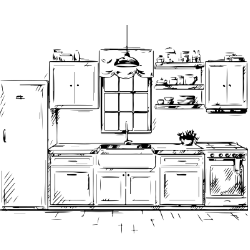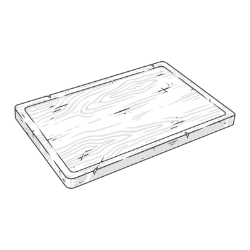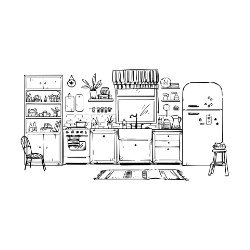
What Color Accent Wall Goes With Gray?

Choosing the perfect color combination for your home decor can be tricky. If you want to create a cohesive look, you'll need to choose colors that complement each other well.
A good rule of thumb is to pick two or three complementary colors and then add them together.
For example, if you love blue and yellow, you might combine those two colors to create a soothing palette.
You don't necessarily have to stick to these rules.
There are plenty of ways to mix and match colors to achieve a harmonious look.
The key is to experiment until you find something you really love.
Here's some inspiration as you begin selecting colors for your space:
For an eclectic feel, try a bold color like bright red or turquoise in one room and neutral tones such as white and gray in another area.
You can also use contrasting pairs to bring out the beauty of various rooms within your home.
For example, you could choose earthy shades of browns and greens for the living room, while choosing cool blues and purples for the bedroom.
If you're unsure where to start when picking colors, consider adding neutrals to the mix.
Neutral colors like taupe, tan, cream, and gray will help to break up more complex palettes. They work equally well in both large-scale designs and smaller spaces alike.
When looking at potential combinations, keep in mind that there are no hard-and-fast rules about which colors go together.
Colors may appear similar on paper, but they often differ dramatically in person.
So make sure you pay close attention to how different hues play against each other before committing to any design decisions.
Doing so can save you from making costly mistakes and ensure that all the color choices you make fit into the overall scheme of your home (or even your neighborhood).
Color Combinations By Room

Here we take a closer look at specific types of rooms and their corresponding color schemes. You may notice that certain elements tend to dominate a particular space.
For instance, if you're considering using accent walls, think carefully about this factor and plan accordingly.
You may enjoy mixing and matching specific colors throughout your home.
The best way to introduce new colors to your home is to gradually integrate them into existing decorative styles.
This means starting small. Start with a single accent wall, or paint a few pieces of furniture in unexpected hues.
Expand your palette to include additional items as you become confident with the effect.
Once you've integrated enough new pieces, you can move on to more significant changes — like painting the entire room or repainting the trim and doors.
Don't rush through this process. The trickiest part of applying a new color scheme is getting rid of old ones.
It's easy to fall in love with color quickly — especially if you've been waiting years to change your home.
But if you do so without giving yourself adequate preparation, you may be disappointed.
Take your time to learn everything you can about the most important aspects of a paint job: the finish, the products you need, and the cost involved.
Before you begin, read the following sections on prep work and finishing your project.
Accent Walls
An accent wall is a great way to inject personality into a space.
But whether you opt for a simple pattern, stenciled lettering, or brightly colored art, remember to select a complementary shade for the rest of the room.

Choosing complementary colors can be an effective strategy when designing a space.
For example, when you pair two colors with opposite undertones, you get a neutral end result, making it easier to coordinate colors around a theme.
For instance, say you want to create a warm, inviting atmosphere in a winter kitchen. You should consider pairing red accents with light blue accents to achieve this effect.
This approach works because the red is offset by the more cool blue. As a result, the combination looks neither too hot nor too cold.
You may even decide to incorporate some yellow accents, which have a tendency to balance the red and blue.
With a bit of practice, you'll soon develop a knack for color planning, and you'll be ready to apply the same technique to other spaces.
If you'd rather not go the complementary route, consider picking one color as the main focus and adding more minor details in artwork, accessories, or window treatments.
Picking a focal point helps you avoid visual clutter while creating an impactful design.
And since you can still add interest with subtle touches, you won't feel overwhelmed by all the options available.
One final note: Don't forget about the floors! Choosing a flooring material that complements your desired paint color will help tie together the whole room.
Whether you choose hardwood, tile, or carpet, keep in mind that wood tones are usually more versatile than concrete alternatives.
However, when the right flooring choice is made, it's common to find that walls don't look quite right anymore.
They might seem too dark or flat against their surroundings. If you're struggling to find the perfect combination, consider these few suggestions:
If you're looking to brighten up a dull room, try using lighter shades of gray. This will make your walls appear brighter in comparison.
On the flip side, if you prefer to bring out the dramatic qualities of your space, use darker hues.
You'll also benefit from having a variety of textures on hand.
A smooth surface will create a sense of uniformity and a monotonous appearance that doesn't reflect any specific mood.
So if you want to add a splash of energy to a bland living area, try mixing things up with a rough-textured rug.
The best thing about combining paint and color schemes is there is no right or wrong answer. Each space is different, so you must decide how you want to live within your own limits.
However, remember that a well-planned color scheme can do wonders for any home decorating project.
Take advantage of the tips in this post to transform your space in ways both big and small. After all, a beautiful finish only gets better once you've moved in.
Color Theory
To design your interiors correctly, you need to know the exact colors that work best in your decor theme.
Knowing the color wheel will play a crucial role in choosing the right shade pairings. There are several versions of the color wheel used today.
There are basically three types of color wheels used in interior design:
- The additive color wheel (also known as the additive model)
- The subtractive color wheel
- The Munsell color circle
We will use the additive color wheel to determine the complementary color pairs for each hue.
The complementary color theory states that two colors — red and green — appear opposite each other when viewed next to each other and together.
While it may be tempting to pick bolder hues for your palette, avoid going overboard.
Avoid pairing contrasting colors close to each other because they tend to compete for attention.
In fact, contrast creates harmony between colors and helps them stand out. So instead, opt for a harmonious combination that includes at least one similar tone.
As a result, you'll have greater control over the colors' placement and enhance the overall composition.
Additive Vs. Subtractive Color Wheel
The additive color wheel relies on light waves, which use pure pigment mixed with white or black ink to produce solid colors, unlike the subtractive color wheel.
It consists of 12 equal-sized segments called primary colors.
These include red, yellow, blue, and violet. Additively speaking, the four colors form a prism-like structure that allows us to see their full range of shades.
If you plan to remodel your kitchen, you should definitely consider updating the cabinets.
They can significantly alter the look of your entire room by simply changing the style and color of your cabinets.
In addition, you can instantly create a new room layout.
In addition to the following suggestions, you should also read up on what type of wood you prefer to work with, the kind of sink you'd like, and whether you'd like stainless steel appliances or not.
Conclusion
There's no way to deny that the number of choices available to consumers has increased exponentially over the last few decades.
So whether you want to update your current home decor or spruce up a bathroom, you now have more options.
But don't let all this information overwhelm you.
Instead, take advantage of the resources offered here and figure out which ones fit within your budget and preferences best.
Good luck!





